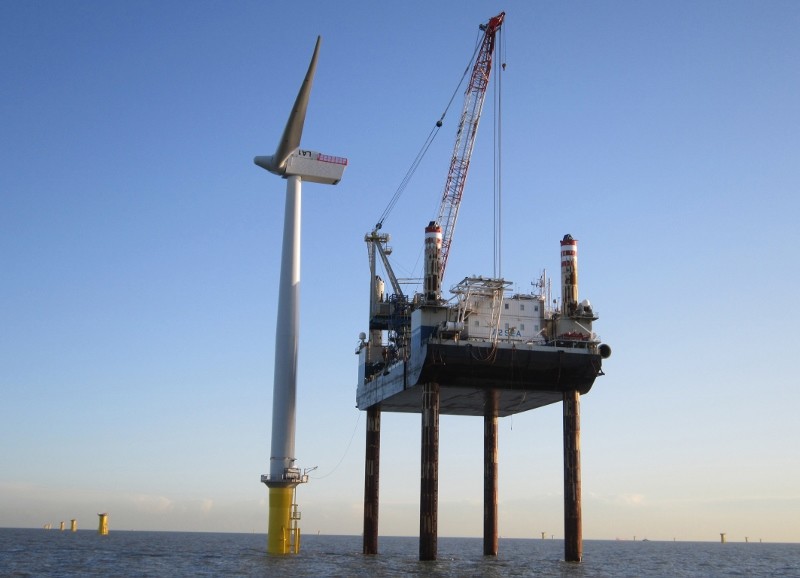President Biden’s offshore wind initiative, a commitment for 30 gigawatts (GW) of offshore wind recently announced by the U.S. Department of Energy, sets the stage for a boost in demand for a range of diesel technology necessary to deliver the promise of zero-emissions electric power.
Whether on land or offshore installation, President Biden’s commitment to dramatically boosting wind energy will rely substantially on high-powered and specialized diesel engines, essential at every step in the process, and the newest generation of near-zero emissions diesel technology is ready for work. From the transport of turbine and tower components by water, rail and land, to site preparation, installation and cable laying operations, in each instance, diesel is the technology of choice because it can uniquely provide the mobile power, performance, reliability and efficiency necessary to build the wind energy future.
According to the U.S. Energy Information Administration, wind farms are the leading source of renewable sources of power generation in 2020, making up 43 percent of all power generated by renewables, and the supply of wind power is expected to continue to expand according to the most recent Short Term Energy Outlook.
The marshalling of resources needed to transport, assemble and construct large wind farms is a considerable undertaking. Diesel-powered construction machines will be essential for land-side and port site preparation and material handling, while installation and servicing the turbine network laying cable, installing towers and footings and associated infrastructure requires specialized rigging and crane equipment and custom-built diesel powered marine workboats and other vessels.
For nearly all of the equipment, near-zero emissions advanced diesel technology is available. Relative to previous generations, these fourth generation – ‘Tier 4’ – solutions reduce particulate matter and nitrogen oxide emissions by more than 80% compared to earlier generations, helping to dramatically reduce the impacts on communities located near ports and support facilities. Recent research shows that a single marine workboat powered by Tier 4 diesel engines eliminates as much emissions in a single year as taking almost 100 tractor-trailer size Class 8 trucks off the road for a single year, relative to previous generations of technology.
Even as these new technologies deliver near-zero criteria pollutant emissions, they are also more efficient, doing more work and providing more power while using less fuel, which translates into lower greenhouse gas emissions. Beyond these basic advancements, opportunities to further reduce greenhouse gas emissions involve the use of hybrid technologies and renewable biodiesel fuels.
Diesel hybrid solutions are also now available for a number of large engine applications including construction machines, marine vessels, ferries and workboats and deliver fuel savings benefits that translate into substantial greenhouse as emission reductions. For example, new tugs in service in Lake Erie couple Tier 4 near-zero emissions diesel engines with hybrid solutions to further reduce fuel consumption and greenhouse gas emissions by 50% and emissions of fine particles by 70%.
Diesel engines old and new are capable of operating on advanced biofuels including renewable diesel fuel and blends of biodiesel that have been shown to reduce greenhouse gas emissions significantly. While zero-emissions options are not available for many of these large off-road applications, including the most used construction equipment and specialized marine vessels, the use of biodiesel and renewable diesel fuel can significantly reduce the carbon footprint of the operation of this equipment.
According to recent data published by the California Air Resources Board, the use of biodiesel and renewable diesel fuel has eliminated the most greenhouse gas emissions from transportation and mobile sources in California, exceeding that reduced by ethanol and the electrification of cars, trucks and buses. Large off-road engines and marine vessels in California have made the switch to these fuels and reduced their greenhouse gas emissions by more than 80 percent. For example, in 2018, all passenger ferry operators in the San Francisco Bay Area announced their switch to operate using 100% renewable diesel fuel to eliminate 22,000 tons of greenhouse gas emissions per year.
Diesel technology will be critical to deliver the promise of clean and affordable renewable electric power from wind energy. The latest innovations in the diesel platform will also contribute to improving air quality for near-port communities and reducing greenhouse gas emissions to the benefit of everyone, and is ready for action.
Allen Schaeffer is executive director of the Diesel Technology Forum, an educational association representing diesel engine, vehicle and equipment manufacturers.




